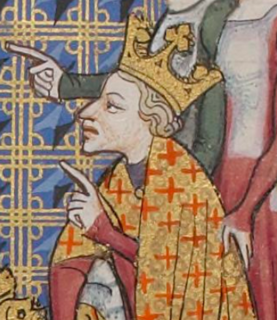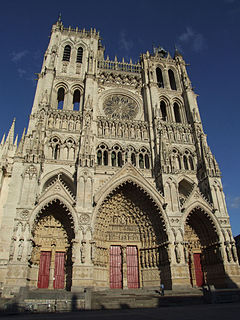
Hugh Capet was the King of the Franks from 987 to 996. He is the founder and first king from the House of Capet. The son of the powerful duke Hugh the Great and his wife Hedwige of Saxony, he was elected as the successor of the last Carolingian king, Louis V. Hugh was descended from Charlemagne's sons Louis the Pious and Pepin of Italy through his mother and paternal grandmother, respectively, and was also a nephew of Otto the Great.

Charles II, called Charles the Bad, was King of Navarre 1349–1387 and Count of Évreux 1343–1387.

Charles V, called the Wise, was King of France from 1364 to his death. His reign marked an early high point for France during the Hundred Years' War, with his armies recovering much of the territory held by the English, and successfully reversed the military losses of his predecessors.

The Jacquerie was a popular revolt by peasants that took place in northern France in the early summer of 1358 during the Hundred Years' War. The revolt was centred in the valley of the Oise north of Paris and was suppressed after a few weeks of violence. This rebellion became known as "the Jacquerie" because the nobles derided peasants as "Jacques" or "Jacques Bonhomme" for their padded surplice, called a "jacque". The aristocratic chronicler Jean Froissart and his source, the chronicle of Jean le Bel, referred to the leader of the revolt as Jacque Bonhomme, though in fact the Jacquerie 'great captain' was named Guillaume Cale. The word jacquerie became a synonym of peasant uprisings in general in both English and French.

Étienne Marcel was provost of the merchants of Paris under King John II of France, called John the Good. He distinguished himself in the defense of the small craftsmen and guildsmen who made up most of the city population.

John V of Armagnac, the penultimate Count of Armagnac of the older branch. He was the son of John IV of Armagnac and Isabella of Navarre.

Charles de Bourbon was a French prince du sang and military commander during the struggles over religion and the throne in late 16th century France. A first cousin of King Henry IV of France, he was the son of the Huguenot leader Louis I de Bourbon, prince de Condé and his second wife, Françoise d'Orléans-Longueville. He gave his name to the Hôtel de Soissons after his title Count of Soissons.
Louis of Lower Lorraine, Frankish royalty and a member of the Carolingian dynasty, was a younger son of Charles, Duke of Lower Lorraine, through his second wife, Adelaide.

The Roman Catholic Diocese of Amiens is a diocese of the Latin Rite of the Roman Catholic Church in France. The diocese comprises the department of Somme, of which the city of Amiens is the capital.

Joan of France, also known as Joan or Joanna of Valois, was the daughter of John II of France, and his first wife, Bonne of Luxembourg. She married Charles II of Navarre, and became Queen-consort of Navarre.

The Roman Catholic Diocese of Soissons, Laon, and Saint-Quentin is a diocese of the Latin Rite of the Roman Catholic Church in France. The diocese is suffragan to the Archdiocese of Reims and corresponds, with the exception of two hamlets, to the entire Department of Aisne. The current bishop is Renauld Marie François Dupont de Dinechin, appointed on 30 October 2015. In the Diocese of Soissons there is one priest for every 4,648 Catholics.

Nicolas de Pellevé was a French archbishop and Cardinal. He was a major figure of the Catholic League.

Robert de Lenoncourt was a French bishop, Cardinal, and diplomat. He was the son of Thierry de Lenoncourt, Seigneur de Vignory, Councillor and Chamberlain of the King, and Jeanne de Ville. He had a brother, Henry, Sire de Lenoncourt and Baron of Vignory, a sister named Jacquette, who married Jean d'Aguerre, son of the Governor of Mouzon, and a sister named Nicole, who married Érard du Châtelet. Robert's paternal uncle, also called Robert de Lenoncourt, was Archbishop of Reims.
The Great Ordinance of 1357 was an edict through which Étienne Marcel attempted to impose limits on the French monarchy, in particular in fiscal and monetary matters.
Louis de Bourbon-Vendôme, was the son of Francis, Count of Vendôme and Marie of Luxembourg and a French prince du sang and religious leader.

Pierre (I) d’Orgemont was a French politician of the Hundred Years' War era.
The Estates of Navarre(French: États de Navarre, États généraux de Navarre, Cortes de Navarre) were created in 1317 under Philip II. The Estates of Lower Navarre(French: États de Basse-Navarre, Cortes de la Basse-Navarre) were first called into session on 28 August 1523 by Henry II after the definitive loss of Upper Navarre,
The siege of Cambrai was undertaken by an English army led by King Edward III of England during September and October 1339 in the early stage of the Hundred Years War. At the time Cambrai, located in the Nord department of the Hauts-de-France region in France, was not part of France but a Free imperial city of the Holy Roman Empire.

A bourgeois of Paris was traditionally a member of one of the corporations or guilds that existed under the Ancien Régime. According to Article 173 of the Custom of Paris, a bourgeois had to have possess a domicile in Paris as a tenant or owner for at least a year and a day. This qualification was also required for public offices such as provost of the merchants, alderman or consul, but unlike the bourgeois or citizens of other free cities, Parisians did not need letters of bourgeoisie to prove their status.

Louis IV, called d'Outremer or Transmarinus, reigned as king of West Francia from 936 to 954. A member of the Carolingian dynasty, he was the only son of king Charles the Simple and his second wife Eadgifu of Wessex, daughter of King Edward the Elder of Wessex. His reign is mostly known thanks to the Annals of Flodoard and the later Historiae of Richerus.















